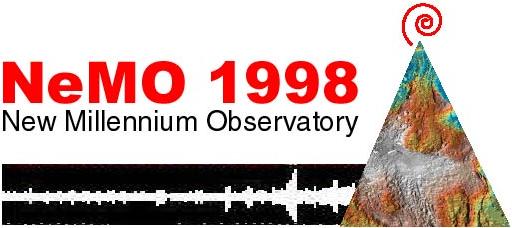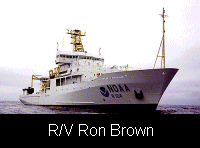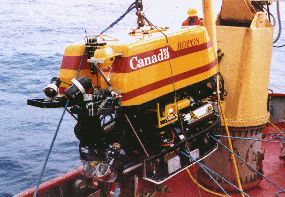WHAT'S NEW:
Deepsea Image Galleries on Multimedia page
(posted 9/15/98)
Eruption Confirmed!
New lava (rumbleometer stuck in flow) SE rift zone
(posted 9/1/98)
BACKGROUND:
Technology (ROV, ships, etc.)
Other 1998 Axial cruise reports
EXPEDITION:
Science Objectives
Calendar
Today's Science News
Participant Perspective
Teacher Logbook
EDUCATION:
Curriculum
Teacher Observations
Questions/Answers from sea
MULTIMEDIA:
(video clips, animations, sounds)

TECHNOLOGY/TOOLS
SHIP:

NOAA Ship Ron Brown
Operated by the Office of NOAA Corps Operations, the Ron Brown was launched May 30, 1996. (Sister ships include the UW's Thomas Thompson, SIO's Roger Revelle and WHOI's Atlantis). The Brown can accommodate 35 scientists and 20 crew members for 60 days with a range of 11,300 nautical miles.
Remotely Operated Vehicle (ROV):

ROPOS
ROVs are used when fine-scale mapping and sampling are required on the seafloor. Unlike manned submersibles which have very limited bottom time, ROVs can explore the seafloor for unlimited amounts of time before coming to the surface. NeMO will be using the Remotely Operated Platform for Ocean Science (ROPOS) on the 1998 Ron Brown Cruise. 23 days of the cruise are available for ROV dives.
Science Instruments:
Included on ROPOS
1) SIT camera
2) Color 3-chip camera
3) 5 and 7 function manipulators
4) Mesotech forward-looking sonar
5) Depth, heading, altitude measurements
6) Still camera (35 mm)
7) Standard sample tray
Project-Specific Instrumentation
1) PMEL fluid sampler
2) Ti Gas samplers
3) SUAVE scanner
4) BioBox
5) PacMan
6) Hi-Temperature probe
7) Niskin bottles
8) Suction sampler
9)Digital camera
10)Imagenex downward-looking scanning sonar
Deployed Instrumentation
1) Extensometers
2) HOBO Hi-temp probes (up to 4)
3) Low-temp probes (up to 10)
4)Osmosamplers (MBARI)
5) SUAVE
6)Time-lapse camera(s)
7) Markers
8) Bacteria traps (microbial colonization chambers)
9) Seafloor navigation beacons (transponders)